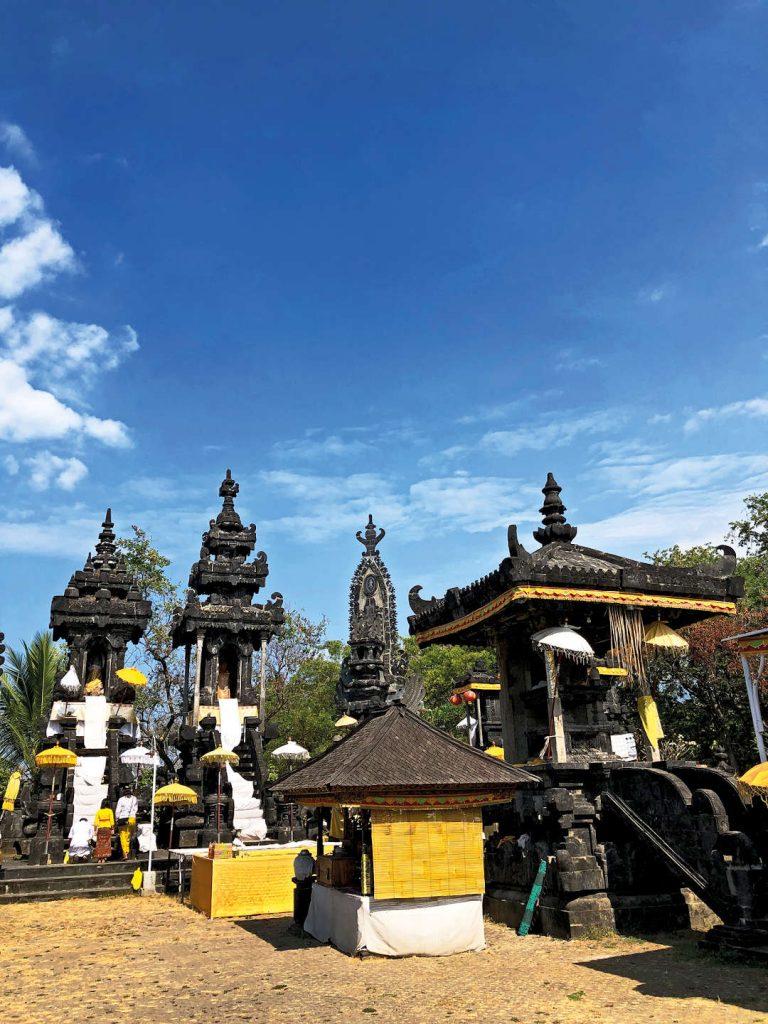Julah village in Tejakula, Buleleng regency, is one of the areas in Bali where old traditions live on. Here, a sea temple attracts the pilgrims looking to be blessed with prosperity for their business, artists for skilful hands to create works of arts, and fishermen for an abundant catch on a day out at sea.
Tejakula is made up of a number of coastal hamlets decorated with volcanic rock hills. And on the coastline of the area’s Julah village lies Pura Ponjok Batu, once the stopover for the holy Hindu priest, Dang Hyang Nirartha, on his pilgrimage from Java.
It is said that when Dang Hyang Nirartha arrived at the location of the temple, he spotted a stranded boat just off the beach. He then went and helped the passengers of the boat, who were sailors from neighbouring Lombok. To commemorate this event, a small boat carved out of a rock was placed at the same spot, by a temple, back in the 90s.

The name Pura Ponjok Batu, meaning “stone on the edge”, explains the temple’s location. It sits on the corner of a small peninsula and the structure itself is made from volcanic rock. Based on the discovery of an ancient, four-handed Catur Buja statue and a Lembu Nandini (female ox) carving, it is predicted that the temple was built in the 8th to 13th century, during the period when both statues were made.
At the front of one of the temple’s structures, the Gedong Bhatara Sakti Wawu Rawuh, there IS A sign that reads “Dwa Kerthi Ngastiti Widhi”, which means Çaka 1882 or 1960 AD. This is the year in which the temple underwent major restorations.



In 1960, this was the time when the restoration of the gedong pelinggih was carried out where almost all the buildings here were made of carved concrete. On the seashore on the front of the temple across the road to Tejakula there is a fresh spring exit and this is where people take tirtha, or holy water, for ceremonies. At the time of high tides, these fresh springs are invisible. Therefore the tirtha monument was made on the beach which is a bit high for the place of maturity.
On the temple’s main grounds, five tall shrines dedicated to Baruna (ruler of the seas), Ganesha (the Hindu deity reminiscent of an elephant), God Shiva, Dang Hyang Nirartha, and God Almighty Sang Hyang Widi, all stand high. In addition to the main five, there are other shrines that decorate Pura Ponjok, dedicated to other Balinese Hindu deities, such as Ratu Bagus Mas Pengukiran, Ratu Ayu Pangenter, Ratu Bagus Mas Subandar, and Ratu Bagus Penyarikan.

An excavation on the site of Pura Ponjok Batu, during a temple renovation in 1995, found a sarcophagus that dated back to 2500 – 3000BC. This finding, along with several archaeological studies, suggested that the temple and its surrounding areas were inhabited by people practicing this unique burial system using the rock coffin. The sarcophagus is now kept in Pura Duhur, Kayuputih village, also in Buleleng regency.

With that being said, on the beach area of Pura Ponjok Batu, a shrine is built to indicate another holy spots belonging to the temple. Here lies a fresh water spring, whose water is believed to be holy and used for may religious ceremonies. In addition to collecting the holy water, pilgrims also come here to perform Melukat cleansing rituals, guided by the temple priests who guard Pura Ponjok Batu. The spring is only accessible during low tide. Visitors are also welcome to perform the cleansing ritual.

Pura Ponjok Batu with its fresh water spring plays a vital role in the religious importance of other surrounding temples, such as Pura Bukit Sinunggal in the neighbouring Tajun village. A number of important ceremonies are held in Pura Bukit Sinunggal; and prior to these ceremonies, cleansing rituals must be performed at Pura Ponjok Batu.
OTHER NEARBY ATTRACTIONS
A short drive to the west from Pura Ponjok Batu will take you to Air Sanih, or Yeh Sanih, a complex of swimming pools of fresh spring water. One of the very few natural swimming pools on the island, the spring’s source of Air Sanih is Lake Batur from where the water flows through an underground channel.

Singaraja, the capital of Buleleng regency, is some 30-minute drive to the west from Air Sanih. En route you’ll encounter a traditional market, where you get to see the commercial trade of farming and fishing communities from up close. Convenience stores and modern shops also line the main road connecting Tejakula and Singaraja, selling a wide range of goods such as music instruments, souvenirs, electronic appliances, and more.
Once in Singaraja, you can wander the narrow streets and observe a raw, vibrant and crowded neighbourhood, where abandoned and decaying old coffee and tobacco warehouses are to be found along with Dutch-style shophouses in bad repair.
Of course, when in North Bali a visit to Lovina is mandatory. Located some 10 kilometres away to the west from Singaraja, the beach in Lovina spans approximately 2 kilometres and it encompasses several small costal villages with Kalibukbuk village as its main focal point. The Lovina beach is a great escape from the bustling, popular beaches found in South Bali such as Kuta, Legian, and Seminyak that are often, if not always, crowded. The waves here are calmer, providing a perfect spot for a swim.






